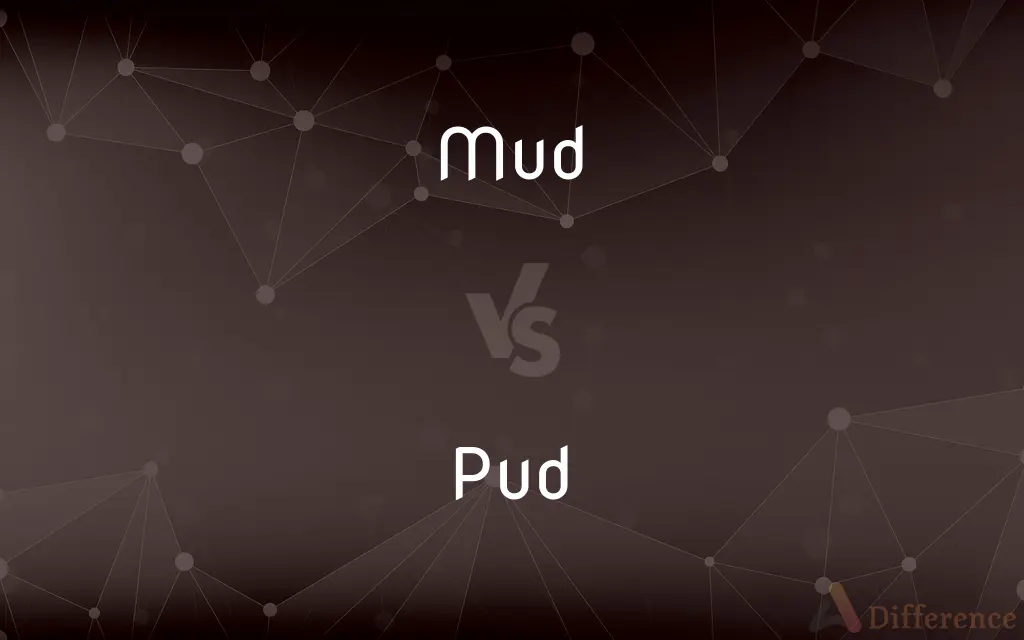Mud vs. Pud — What's the Difference?
Edited by Tayyaba Rehman — By Urooj Arif — Updated on March 27, 2024
Mud is a wet, soft earth or earthy matter, while pud is a colloquial term for pudding, often sweet and served as dessert.

Difference Between Mud and Pud
Table of Contents
ADVERTISEMENT
Key Differences
Mud is a mixture of water and any combination of soil, silt, and clay, and it's often found in natural or outdoor environments, especially after rain. It is typically malleable when wet and can harden when it dries. Pud, on the other hand, is a British informal term for pudding, which refers to a wide range of desserts, including those that are baked, steamed, or boiled. The term "pudding" can also encompass savory dishes in some contexts, but "pud" usually refers to sweet dishes.
Mud plays a significant role in various outdoor activities, construction, and even skincare, being valued for its therapeutic properties in some cultures. Whereas pud is primarily associated with comfort food, often enjoyed at the end of a meal or as a treat, highlighting the cultural and functional divergence between the two.
In terms of consistency and composition, mud can vary widely depending on the ratio of water to soil and the type of earth materials involved. It can range from a thick, sticky substance to a thin, watery slurry. Pud, in contrast, has a much more uniform texture, typically smooth and creamy or soft and spongy, depending on the preparation method and ingredients.
The significance of mud extends beyond its physical presence; it has ecological importance, providing habitat for various organisms and playing a crucial role in processes like water filtration. Pud, while lacking ecological impact, holds cultural significance, especially in the UK, where it is a traditional component of meals and celebrations.
Mud and pud also differ in their sensory and aesthetic appeal. Mud is often associated with messiness and dirtiness, something to be cleaned up or avoided in certain contexts. Pud, conversely, is tied to notions of sweetness, comfort, and indulgence, appealing to the senses of taste and smell.
ADVERTISEMENT
Comparison Chart
Nature
Natural mixture of water and earth materials.
Culinary term for a range of sweet or savory desserts.
Primary Association
Outdoor activities, construction, and skincare.
Comfort food, especially desserts.
Texture
Varies from thick and sticky to thin and watery.
Generally smooth and creamy or soft and spongy.
Significance
Ecological importance, habitat for organisms.
Cultural significance, especially in the UK.
Sensory Appeal
Associated with messiness and cleanliness concerns.
Tied to sweetness, comfort, and indulgence.
Compare with Definitions
Mud
Construction material.
They used mud bricks for building the house.
Pud
Sweet, soft dessert.
My grandmother makes the best bread and butter pud.
Mud
Mess or mire.
The festival grounds turned into a sea of mud.
Pud
Comfort food.
I could really go for some sticky toffee pud right now.
Mud
Skincare substance.
She applied a mud mask for its cleansing properties.
Pud
Steamed or baked dessert.
We enjoyed a warm, spiced plum pud during the holidays.
Mud
Wet soil or earth.
After the rain, the garden was covered in thick mud.
Pud
Traditional British dessert.
Christmas wouldn't be the same without a rich, fruity Christmas pud.
Mud
Silt or clay.
The riverbanks were slippery with mud.
Pud
British term for dessert.
For dinner, we'll have steak and kidney pie with a chocolate pud for dessert.
Common Curiosities
Is pud eaten only as a dessert?
Primarily, yes, but it can also refer to some savory dishes in traditional contexts.
What is pud short for?
Pud is short for pudding, referring mainly to sweet desserts in modern usage.
What is mud used for?
Mud is used in construction (mud bricks), skincare (mud masks), and various forms of art and play.
Are all puddings considered pud?
In informal British English, many types of desserts are colloquially called pud.
How do you make a basic pud?
Basic sweet pud can be made by combining ingredients like flour, sugar, and milk, then baking or steaming.
Is pud only a British term?
Yes, pud is primarily British slang for pudding, especially desserts.
Can mud be harmful?
While generally not harmful, mud can contain bacteria or contaminants, depending on its source.
How is mud created?
Mud is created by mixing water with soil, silt, or clay.
Can pud be a savory dish?
Traditionally, yes, but in contemporary usage, it usually refers to sweet dishes.
Is mud only found outdoors?
Primarily, yes, though it can be artificially created for specific uses like in spas.
Why is mud important to the environment?
Mud plays a crucial role in ecosystems, supporting plant growth and serving as a habitat for various organisms.
Does mud have health benefits?
Certain types of mud are believed to have therapeutic properties, especially for the skin.
What types of mud are there?
Types of mud vary based on their composition, including clay mud, silt mud, and others.
What's a popular type of pud?
Sticky toffee pudding is a beloved type of pud in the UK.
Can mud be used in sports?
Yes, mud is often a component of obstacle courses and mud sports events.
Share Your Discovery

Previous Comparison
Always vs. Constantly
Next Comparison
Afford vs. BearAuthor Spotlight
Written by
Urooj ArifUrooj is a skilled content writer at Ask Difference, known for her exceptional ability to simplify complex topics into engaging and informative content. With a passion for research and a flair for clear, concise writing, she consistently delivers articles that resonate with our diverse audience.
Edited by
Tayyaba RehmanTayyaba Rehman is a distinguished writer, currently serving as a primary contributor to askdifference.com. As a researcher in semantics and etymology, Tayyaba's passion for the complexity of languages and their distinctions has found a perfect home on the platform. Tayyaba delves into the intricacies of language, distinguishing between commonly confused words and phrases, thereby providing clarity for readers worldwide.














































